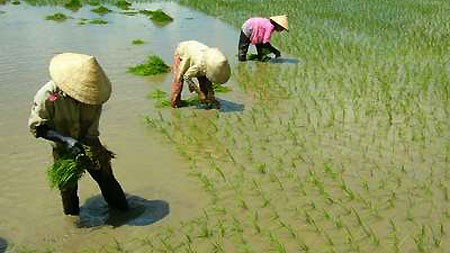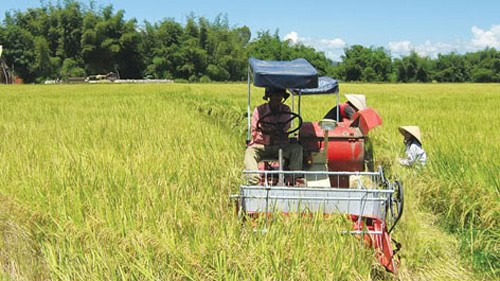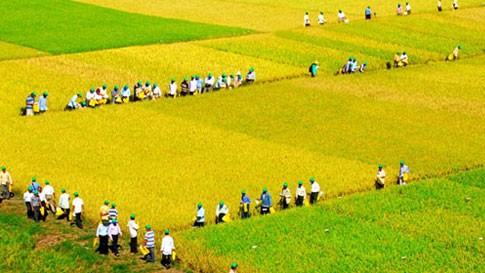(VOVworld) – Of the 54 ethnic groups in Vietnam, it was the Viet people who settled in the Red River delta and engaged in wet rice cultivation. Through different stages of development, wet rice cultivation not only fed the people but also created a traditional culture – the Red River civilization. On today’s edition of Colorful Vietnam-Vietnam’s 54 ethnic groups, VOV reporter To Tuan reveals more about the Viet people’s wet rice cultivation.
 |
| Farmers are growing rice |
The Red River delta, which was formed by the alluvial deposits of two major rivers - the Red River and Thai Binh River - was the original habitation of the ancient Viet people. The Viet ancestors tamed wild rice for cultivation. Taking advantage of tropical factors such as hot, humid weather and abundant ponds and rivers, they adopted wet rice cultivation for livelihood. Naturally, rice was chosen as a staple food and their meals consist mainly of boiled rice, vegetables, and fish. Throughout their history, Viet people have steadily gained experiences in rice growing, irrigation, dyke embankment, canal digging, and techniques to increase crops. People’s lives have depended largely on nature, gradually forming customs, habits, rituals and beliefs such as worshipping ancestors and the Gods of Rain, Wind, Thunder and Lightning. The Red River delta civilization has produced a wide range of arts, including cheo classical opera and water puppetry.
Being long time indigenous, the Viet people were pioneers in conquering the nature and developing wet rice cultivation. Vietnam’s major rice granaries in the northern delta, the central coast and southern delta are inhabited by a large number of Viet people. Wet rice cultivation has fed many generations, but it was given a boost 20 years ago when the Vietnamese State adopted a policy of allocating farm land to farmers. Doctor Vo Tong Xuan says this policy made a difference: “Vietnam began to export rice in 1989, shifting from a food deficiency period to a rice export period. This growth was due to scientist finding new rice strains and State investment in irrigation projects. Furthermore, proper policies encouraged farmers to produce more rice for their families and for export”.
 |
| Machines help ease farm work |
In 2 decades, from a nation with food shortages, Vietnam has become one of the biggest rice exporters in the world. In 2012, Vietnam exported more than 7 million tons of rice, ranking 2nd in the world. In recent years, the implementation of a new rural area program with detailed criteria for planning, model rice fields and technological application has helped boost rice productivity and values. Rice cultivation has been modernized. Nguyen Thi Tam, a farmer in Hanoi’s Quoc Oai district, told us: “Our commune is in urgent need of machines, which help ease farmers’ labour. The machines also help reduce costs such as for rice seedlings and water”.
Rice has fed the people and even brought them wealth. Nguyen Huu Lai, a farmer in An Giang province in the southern delta, says: “Formerly, we grew rice on small scale. But now households work together in larger rice fields with the same rice strain. There are model rice fields”.
 |
| Models of large rice fields |
During Vietnam’s international integration process, the wet rice civilization of the Red River delta continues to shine, providing an abundant source of food and making Vietnamese culture thrive.